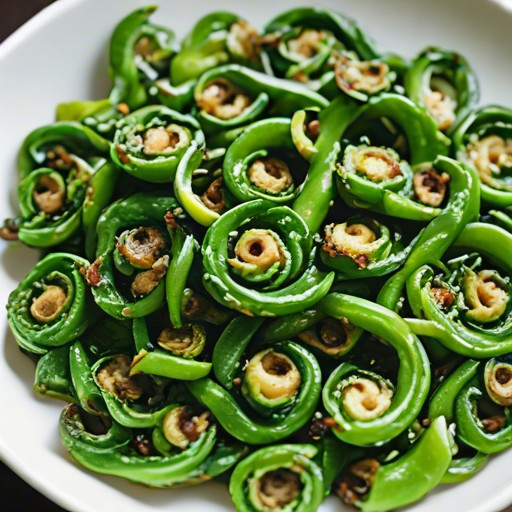Elevate Your Cooking Game with Sauteed Fiddleheads
Embark on a culinary adventure with a unique and delightful dish featuring one of nature’s treasures – Sauteed Fiddleheads. Fiddleheads, the tightly coiled shoots of the ostrich fern, are a seasonal delicacy with a distinct flavor reminiscent of asparagus and artichokes. In this recipe, we’ll explore how to sauté these tender fiddleheads to perfection, enhancing their natural flavors with garlic, lemon juice, and a touch of seasoning. Whether you’re a seasoned cook looking to expand your repertoire or an adventurous foodie eager to try something new, sautéed fiddleheads are sure to impress. Join us as we delve into the ingredients, techniques, and variations that make this dish a standout favorite.
Ingredients:
- 3 cups fresh fiddlehead ferns
- 1 clove garlic, minced
- 1 tablespoon fresh lemon juice
- 1/2 teaspoon black pepper
- 1/2 teaspoon sea salt
- 3 tablespoons extra-virgin olive oil
Instructions:
- Prepare the Fiddleheads:
- Start by rinsing the fiddleheads under cold water to remove any dirt or debris. Trim off any brown ends or tough stems, if necessary.
- Saute the Garlic:
- Heat the olive oil in a large skillet over medium heat. Add the minced garlic and sauté for 1-2 minutes until fragrant, being careful not to brown the garlic.
- Add the Fiddleheads:
- Carefully add the cleaned fiddleheads to the skillet, spreading them out in a single layer. Allow them to cook undisturbed for 4-5 minutes, allowing them to develop a golden brown color on one side.
- Season and Finish Cooking:
- Season the fiddleheads with salt, pepper, and fresh lemon juice. Use tongs or a spatula to toss them gently and ensure even cooking. Continue to sauté for an additional 3-4 minutes until the fiddleheads are tender but still crisp.
- Serve Hot:
- Transfer the sautéed fiddleheads to a serving dish and garnish with a sprinkle of fresh lemon zest, if desired. Serve hot as a flavorful side dish or appetizer.
Cook Notes and Variations:
- Blanching Method: Some cooks prefer to blanch the fiddleheads in boiling water for 2-3 minutes before sautéing to ensure they are fully cooked and tender. This step can help reduce bitterness and enhance the color of the fiddleheads.
- Flavor Enhancements: Experiment with additional flavorings such as chopped fresh herbs (parsley, thyme, or chives), grated Parmesan cheese, or a drizzle of balsamic glaze to add depth and complexity to the dish.
- Texture Variation: For a crispier texture, try dusting the fiddleheads with a light coating of flour or cornstarch before sautéing. This will help create a golden crust while keeping the fiddleheads tender on the inside.
Keto and Low-Carb Versions:
Keto Version:
- Sauteed fiddleheads are naturally low in carbs, making them a keto-friendly option for those following a ketogenic diet. Simply omit any high-carb ingredients such as flour or sweeteners, and focus on using keto-approved fats like olive oil or butter for sautéing.
Low-Carb Version:
- To keep this dish low in carbs, stick to the basic ingredients listed in the recipe. Avoid adding any additional sugars or starches, and adjust the seasoning to taste. Serve the sautéed fiddleheads alongside grilled protein or roasted vegetables for a satisfying low-carb meal.
In conclusion, sautéed fiddleheads are a delicious and nutritious addition to any meal. With their delicate flavor and tender texture, they’re a versatile ingredient that pairs well with a variety of dishes. Whether you enjoy them as a simple side dish, toss them into salads, or incorporate them into pasta or rice dishes, sautéed fiddleheads are sure to impress your family and friends. So embrace your adventurous spirit, pick up some fresh fiddleheads, and get ready to elevate your cooking game with this delightful recipe
Frequently Asked Questions (FAQs):
1. What are fiddleheads, and where can I find them?
- Fiddleheads are the young, tightly coiled shoots of the ostrich fern, harvested in early spring. They have a unique flavor reminiscent of asparagus and artichokes. You can often find them at farmer’s markets, specialty grocery stores, or forage for them in wooded areas with damp soil.
2. Are fiddleheads safe to eat?
- Yes, fiddleheads are safe to eat when properly prepared. However, it’s essential to cook them thoroughly to eliminate any potential bacteria or toxins. Additionally, always purchase fiddleheads from reputable sources and avoid consuming them raw.
3. How do I clean fiddleheads before cooking?
- To clean fiddleheads, start by rinsing them under cold water to remove any dirt or debris. Trim off any brown ends or tough stems, and discard any fiddleheads that appear wilted or discolored. Some cooks also recommend soaking the fiddleheads in cold water for a few minutes to ensure thorough cleaning.
4. Can I freeze fiddleheads for later use?
- Yes, you can freeze fiddleheads to enjoy them later. Blanch the cleaned fiddleheads in boiling water for 2-3 minutes, then immediately transfer them to an ice water bath to stop the cooking process. Once cooled, drain the fiddleheads thoroughly and pack them into airtight containers or freezer bags. They can be stored in the freezer for up to six months.
5. What other dishes can I make with fiddleheads?
- Fiddleheads are incredibly versatile and can be used in various dishes, including salads, soups, stir-fries, and pasta dishes. You can also pickle or ferment them for a tangy addition to charcuterie boards or sandwiches.
In conclusion, sautéed fiddleheads offer a delightful culinary experience, showcasing the flavors of spring in a simple and elegant dish. With their tender texture and earthy taste, they provide a unique addition to any meal. Whether you’re a seasoned chef or a novice cook, incorporating fiddleheads into your cooking repertoire is sure to impress your family and friends. So embrace the freshness of spring, explore the bounties of nature, and savor the deliciousness of sautéed fiddleheads. Cheers to culinary adventures and happy cooking!

